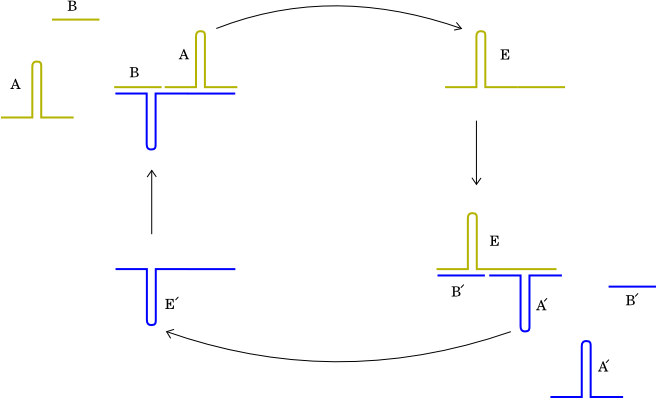
Recall that the first extensive sedimentary rocks, appear around 3.5 bya.
These exhibit chemical signatures of life
---The ratio of C[12]/C[13] is the same as produced by living organisms, and different than what is seen in abiotic systems.
Origin of life.
Early earth: Atmosphere lacked free O2 , was rich in Methane
(CH4), ammonia (NH3) and water.
No ozone layer, so UV would have been much more intense.
Provocative observations:
The last point, along with related observations about the activity of RNA and its ubiquity in biological systems (some viruses have no DNA, but everything has RNA), have led to the suggestion that at one stage, the earth was an "RNA world".
The RNA world hypothesis makes sense of the observations that the sequences of rRNA's are among the most conserved sequences known, and the fact that genes for enzymes that act on RNA are the most widely conserved across different groups.
Self replicating RNA hypercycles
Recent (2009) laboratory experiment succeeded in constructing a system of two RNA enzymes, named E and E', each of which catalyzes the production of the other.
This produces a Hypercycle, a self replicating cycle.
The Ribozyme E is constructed out of two parts, named A and B. The other ribozyme, E', is constructed of A' and B'

Not only does this system replicate with high efficiency and speed, it evolves, as new variants that increase the speed or efficiency of replication appear by mutation or recombination.
Ribozymes that build other RNAs
Recently, a ribozyme was constructed in the lab that could synthesize long RNA sequences.
-- Including tRNAs and parts of ribosomes.
(Horning, D.P. & Joyce, G.F. 2016. PNAS 113, pg 9786-9791)
This ribozyme evolved over multiple generations to become much more efficient than was the original design.
Using this system, researchers were able to run a PCR-like process in which all of the components were RNAs
The shift to DNA
DNA is much more stable that RNA, so it may have been advantageous to shift
to DNA as the genetic material (i.e. what is transmitted between generations), then
convert this back into RNA for the actual work of making proteins and directing
development.
Stromatolites (Pictures)
Built up of layers of microbial mats interspersed
with layers of sediment.
Still found in some areas.
Oxygen being produced by photosynthesis taken up by oxidation of organic compounds and iron.
Proterozoic
Concentration of free oxygen increases in late Archean, early Proterozoic.
Free oxygen destroys most large organic molecules.
Thus would have constituted a deadly poison
for most early life forms.
Increased free oxygen thus precludes further origination of life.
Oxygen greatly increases potential efficiency of metabolism
Respiration, including Krebs Cycle and Oxidative
Phosphorilation produces 30-40 ATPs per Glucose molecule.
vs 2 ATP per glucose from fermentation.
Eucaryotes
First fossils appear around 1.9 bya.
These are single cells
The large scale tree of life
The Last Universal Common Ancestor (LUCA) had both RNA and DNA, Used the same genetic code as modern organisms, and used Ribosomes and ATP/ADP.
Much of the machinery for manipulating DNA, though, was probably not highly developed yet.
Both the Archaea and the Eukarya package DNA into chromatin by wrapping it around histones (one histone molecule in Archaea, 8 in Eukarya). Bacteria do not use histones.
Archaea and Eukarya use the same or similar:
- DNA Primase (creates a primer to initiate DNA synthesis)
- DNA Helicase (separates the DNA strands)
- DNA Polymerase (carries out DNA replication)
Bacteria have molecules (with the same names) to carry out all of these functions, but they are very different from (and not homologous to) those used by Archaea and Eukarya.
Thus, the Eukaryotic cell is a composite of very different kinds of prokaryotes.
Note: this suggests that while the last universal common ancestor (LUCA) had DNA, the machinery for DNA manipulation was not fully developed until after the split of Bacteria and the Archaea-Eukarya group.
Endosymbiosis - One single celled organism takes up life within another. This is the origin of both mitochondria and chloroplasts in Eukaryotes.
Mitochondria - Derived from an  -proteobacterium.
-proteobacterium.
These often involved in endosymbiotic relationships.
Chloroplasts - Derived from a Cyanobacterium.
Multicellular Eukaryotes that closely resemble modern Red Algae appear around 1.1 bya.
Pictures
Red algae are the sister group to Plants and Green Algae.
The presence fossils with well defined red algal traits 1.1 bya suggests that the major groups of eukaryotes had diverged by this time.